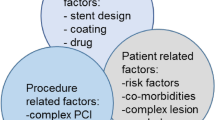Abstract
Purpose:
The GERSHWIN study (German Stent Health Outcome and Economics Within Normal Practice) was designed to evaluate long-term effects of treatment of coronary artery disease (CAD) with sirolimus-eluting stents (SES), as compared to bare-metal stents (BMS).
Patients and Methods:
Within a multicenter, prospective intervention study in 35 hospitals throughout Germany, CAD patients with coronary stenosis and elective percutaneous coronary intervention (PCI) indication were treated either with SES or BMS (sequential control design with a case-to-control ratio of 2 : 1). Standardized questionnaires were completed by patients and their physicians at baseline, 3, 6, 12, and 18 months following PCI to document re-PCI for restenosis, myocardial infarction (MI), coronary bypass surgery (CABG), and death. Angiographic PCI documentation was evaluated by an independent expert.
Results:
From April 2003 until June 2005, 658 patients were treated with SES (mean age 63 ± 9 years, 87% male) and 294 patients with BMS (mean age 64 ± 10 years, 79% male). Significant baseline differences were found by age, gender, household status, threevessel disease, and number of implanted stents. After 18 months, 8% of the SES versus 17% of the BMS group had undergone target vessel revascularization (p adjusted < 0.0001). There were no significant differences between BMS and SES regarding MI, CABG, or death. Re-PCI of target and new non-target vessel lesions was performed at a significantly lower degree of stenosis in SES than in BMS.
Conclusion:
Compared to patients with BMS, patients with implantation of SES experienced considerably fewer target vessel revascularizations. The threshold to perform re-PCI appeared lower in SES than in BMS. An extended evaluation of the effects of SES will be available from the 3-year follow-up of the GERSHWIN study.
Zusammenfassung
Ziel:
Die GERSHWIN-Studie (German Stent Health Outcome and Economics Within Normal Practice) untersucht die Folgeereignisse nach Implantation von Sirolimus freisetzenden Stents („sirolimus-eluting stent“ [SES]) im Vergleich zu unbeschichteten Metallstents („bare-metal stents“ [BMS]) bei der Behandlung der koronaren Herzerkrankung (KHK).
Patienten und Methodik:
Im Rahmen einer multizentrischen, kontrollierten Studie wurden KHK-Patienten in 35 Kliniken in Deutschland mit Koronarstenosen und Indikation zur elektiven perkutanen Koronarintervention (PCI) mit SES oder konventionellen BMS behandelt (sequentielles Kontrolldesign mit Fall-Kontroll-Ratio von 2 : 1). Die Nachbeobachtung umfasste standardisierte Erhebungen bei den Patienten und den weiterbehandelnden Ärzten zu Studienbeginn, nach 3, 6, 12 und 18 Monaten mit Dokumentation von Re-PCI im behandelten Gefäß, Myokardinfarkt (MI), Bypassoperation (CABG) und Tod. Angiographiebefunde wurden von einem unabhängigen Begutachter beurteilt.
Ergebnisse:
Von April 2003 bis Juni 2005 wurden 658 Patienten mit SES (87% männlich, 63 ± 9 Jahre) und 294 Patienten mit BMS (79% männlich, 64 ± 10 Jahre) behandelt. Signifikante Unterschiede der beiden Patientengruppen zu Studienbeginn zeigten sich bei Alter, Geschlecht, Haushaltsstatus, Dreigefäßerkrankung und Anzahl der implantierten Stents. In den ersten 18 Monaten traten bei SES 8% und bei BMS 17% Restenosen im behandelten Gefäß auf (p adjustiert < 0,0001). Es gab keine signifikanten Unterschiede zwischen den beiden Gruppen bei MI, CABG oder Tod. Re-PCI der behandelten Gefäße bzw. neue Läsionen außerhalb des behandelten Gefäßes wurden bei SES schon bei einem geringeren Stenosegrad durchgeführt als bei BMS.
Schlussfolgerung:
Patienten mit SES haben im Vergleich zu BMS nach 18 Monaten deutlich weniger Re-PCI im behandelten Gefäß. Die Bereitschaft, bei SES eine Re-PCI durchzuführen, scheint höher zu sein als bei BMS. Für die klinische Gesamtbetrachtung ist eine Langzeitkontrolle notwendig. Weitere Hinweise werden aus der zusätzlichen Nachbeobachtung der GERSHWIN-Studie bis 36 Monate erwartet.
Similar content being viewed by others
Author information
Authors and Affiliations
Corresponding author
Rights and permissions
About this article
Cite this article
Brüggenjürgen, B., McBride, D., Bode, C. et al. Sirolimus-Eluting Versus Bare-Metal Stents for the Reduction of Coronary Restenosis. Herz 32, 650–655 (2007). https://doi.org/10.1007/s00059-007-3048-2
Issue Date:
DOI: https://doi.org/10.1007/s00059-007-3048-2




